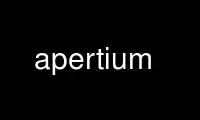
This is the command apertium that can be run in the OnWorks free hosting provider using one of our multiple free online workstations such as Ubuntu Online, Fedora Online, Windows online emulator or MAC OS online emulator
PROGRAM:
NAME
apertium - This application is part of ( apertium )
This tool is part of the apertium machine translation architecture:
http://apertium.sf.net.
SYNOPSIS
apertium [-d datadir] [-f format] [-u] [-a] {language-pair} [infile [outfile]]
DESCRIPTION
apertium is the application that most people will be using as it simplifies the use of
apertium/lt-toolbox tools for machine translation purposes.
This tool tries to ease the use of lt-toolbox (which contains all the lexical processing
modules and tools) and apertium (which contains the rest of the engine) by providing a
unique front-end to the end-user.
The different modules behind the apertium machine translation architecture are in order:
· de-formatter: Separates the text to be translated from the format information.
· morphological-analyser: Tokenizes the text in surface forms.
· part-of-speech tagger: Chooses one surface forms among homographs.
· lexical transfer module: Reads each source-language lexical form and delivers a
corresponding target-language lexical form.
· structural transfer module: Detects fixed-length patterns of lexical forms
(chunks or phrases) needing special processing due to grammatical divergences
between the two languages and performs the corresponding transformations.
· morphological generator: Delivers a target-language surface form for each target-
language lexical form, by suitably inflecting it.
· post-generator: Performs orthographical operations such as contractions and
apostrophations.
· re-formatter: Restores the format information encapsulated by the de-formatter
into the translated text and removes the encapsulation sequences used to protect
certain characters in the source text.
OPTIONS
-d datadir The directory holding the linguistic data. By default it will used the
expected installation path.
language-pair The language pair: LANG1-LANG2 (for instance es-ca or ca-es).
-f format Specifies the format of the input and output files which can have these values:
· txt (default value) Input and output files are in text format.
· html Input and output files are in "html" format. This "html" is the one accepted
by the vast majority of web browsers.
· html-noent Input and output files are in "html" format, but preserving native
encoding characters rather than using HTML text entities.
· rtf Input and output files are in "rtf" format. The accepted "rtf" is the one
generated by Microsoft WordPad (C) and Microsoft Office (C) up to and including
Office-97.
-u Disable marking of unknown words with the '*' character.
-a Enable marking of disambiguated words with the '=' character.
Use apertium online using onworks.net services
